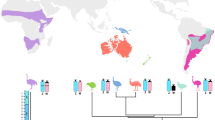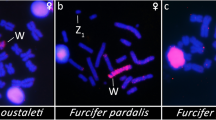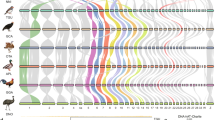Abstract
All extant birds share the same sex-chromosome system: ZZ males and ZW females with striking differences in the stages of sex-chromosome differentiation between the primitive palaeognathus ratites and the large majority of avian species grouped within neognaths. Evolutionarily close to ratites is the neotropical order Tinamiformes that has been scarcely explored regarding their ZW pair morphology and constitution. Tinamous, when compared to ratites, constitute a large group among Palaeognathae, therefore, exploring the extent of homology between the Z and W chromosomes in this group might reveal key features on the evolution of the avian sex chromosomes. We mapped MLH1 foci that are crossover markers on pachytene bivalents to determine the size and localization of the homologous region shared by the Z and W chromosomes in two tinamous: Eudromia elegans and Crypturellus tataupa. We found that the homologous (pseudoautosomal) region differ significantly in size between these two species. They both have a single recombination event on the long arm of the acrocentric Z and W chromosomes. However, in E. elegans the pseudoautosomal region occupies one-fourth of the W chromosome, while in C. tataupa it is restricted to the tip of the long arm of the W. The W chromosomes in these two species differ in their heterochromatin content: in E. elegans it shows a terminal euchromatic segment and in C. tataupa is completely heterochromatic. These results show that tinamous have ZW pairs with more diversified stages of differentiation compared to ratites. Finally, the idea that the avian proto-sex chromosomes started to diverge from the end of the long arm towards the centromere of an acrocentric pair is discussed.






Similar content being viewed by others
References
Ansari HA, Takagi N, Sasaki M (1988) Morphological differentiation of sex chromosomes in three species of ratite birds. Cytogenet Cell Genet 47:185–188
Bergero R, Charlesworth D (2009) The evolution of restricted recombination in sex chromosomes. Trends Ecol Evol 24:94–102
Calderón PL, Pigozzi MI (2006) Mlh1-focus mapping in birds shows equal recombination between sexes and diversity of crossover patterns. Chromosome Res 14:605–612
Charlesworth B, Charlesworth D (2000) The degeneration of Y chromosomes. Philos Trans R Soc Lond B Biol Sci 355:1563–1572
Garnero A, Ledesma M, Gunski RJ (2006) Alta homeologia cariotípica na família Tinamidae (Aves: Tinamiformes). Rev Bras Ornitol 14:53–58
Harshman J, Braun EL, Braun MJ, Huddleston CJ, Bowie RC, Chojnowski JL, Hackett SJ, Han KL, Kimball RT, Marks BD, Miglia KJ, Moore WS, Reddy S, Sheldon FH, Steadman DW, Steppan SJ, Witt CC, Yuri T (2008) Phylogenomic evidence for multiple losses of flight in ratite birds. Proc Natl Acad Sci 105:13462–13467
Huxley TH (1867) On the classification of birds; and on the taxonomic value of the modifications of certain of the cranial bones observable in that class. Proc Zool Soc Lond 145:415–472
Janes DE, Ezaz T, Graves JAM, Edwards SV (2009) Recombination and nucleotide diversity in the sex chromosomal pseudoautosomal region of the emu, Dromaius novaehollandiae. J Hered 100:125–136
Lawson Handley L-J, Ceplitis H, Ellegren H (2004) Evolutionary strata on the chicken Z chromosome: implications for sex chromosome evolution. Genetics 167:367–376
Livezey BC, Zusi RL (2007) Higher-order phylogeny of modern birds (Theropoda, Aves: Neornithes) based on comparative anatomy. II. Analysis and discussion. Zool J Linn Soc 149:1–95
Mank JE, Ellegren H (2007) Parallel divergence and degradation of the avian W sex chromosome. Trends Ecol Evol 22:389–391
Nam K, Ellegren H (2008) The chicken (Gallus gallus) Z chromosome contains at least three nonlinear evolutionary strata. Genetics 180:1131–1136
Nishida-Umehara C, Fujiwara A, Ogawa A, Mizuno S, Abe S, Yoshida MC (1999) Differentiation of Z and W chromosomes revealed by replication banding and FISH mapping of sexchromosome-linked DNA markers in the cassowary (Aves, Ratitae). Chromosome Res 7:635–640
Ogawa A, Murata K, Mizuno S (1998) The location of Z- and W-linked marker genes and sequence on the homomorphic sex chromosomes of the ostrich and the emu. Proc Natl Acad Sci USA 95:4415–4418
Pigozzi MI (1999) Origin and evolution of the sex chromosomes in birds. Biocell 23:79–95
Pigozzi MI (2001) Distribution of MLH1 foci on the synaptonemal complexes of chicken oocytes. Cytogenet Cell Genet 95:129–133
Pigozzi MI (2007) Localization of single-copy sequences on chicken synaptonemal complex spreads using fluorescence in situ hybridization (FISH). Cytogenet Genome Res 119:105–112
Pigozzi MI (2008) Relationship between physical and genetic distances along the zebra finch Z chromosome. Chromosome Res 16:839–849
Pigozzi MI, Solari AJ (1997) Extreme axial equalization and wide distribution of recombination nodules in the primitive ZW pair of Rhea americana (Aves, Ratitae). Chromosome Res 5:421–428
Pigozzi MI, Solari AJ (1999) The ZW pairs of two paleognath birds from two orders show transitional stages of sex chromosome differentiation. Chromosome Res 7:541–551
Pigozzi MI, Solari AJ (2005) Meiotic recombination in the ZW pair of a tinamid bird shows a differential pattern compared with neognaths. Genome 48:286–290
Schmid M, Enderle E, Schindler D, Schemp W (1989) Chromosome banding and DNA replication patterns in bird karyotypes. Cytogenet Cell Genet 52:139–146
Shetty S, Griffin DK, Graves JAM (1999) Comparative painting reveals strong chromosome homology over 80 million years of bird evolution. Chromosome Res 7:289–295
Shetty S, Kirby P, Zarkower D, Graves JAM (2002) DMRT1 in a ratite bird: evidence for a role in sex determination and discovery of a putative regulatory element. Cytogenet Genome Res 99:245–251
Sibley CG, Monroe BL Jr (1991) Distribution and taxonomy of birds of the world. Yale University Press, New Haven
Solari AJ (1993) Sex chromosomes and sex determination in vertebrates. CRC Press, Boca Raton
Solovei I, Gaginskaya ER, Hutchison N, MacGregor H (1993) Avian sex chromosomes in the lampbrush form: the ZW bivalents from six species of birds. Chromosome Res 1:153–166
Takagi N, Itoh M, Sasaki M (1972) Chromosome studies in four species of Ratitae (Aves). Chromosoma 36:281–291
Tsuda Y, Nishida-Umehara C, Ishijima J, Yamada K, Matsuda Y (2007) Comparison of the Z and W sex chromosomal architectures in elegant crested tinamou (Eudromia elegans) and ostrich (Struthio camelus) and the process of sex chromosome differentiation in palaeognathous birds. Chromosoma 116:159–173
van Tuinen TM, Sibley CG, Hedges SB (2000) The early history of modern birds inferred from DNA sequences of nuclear and mitochondrial ribosomal genes. Mol Biol Evol 17:451–457
Acknowledgments
I am grateful to Julio Contreras and Yolanda Davies for their expertise in taxonomic identification of eggs and birds in the wild. This work was supported by grants from the University of Buenos Aires (UBACyT 429) and CONICET (PIP 124) to MIP.
Author information
Authors and Affiliations
Corresponding author
Rights and permissions
About this article
Cite this article
Pigozzi, M.I. Diverse stages of sex-chromosome differentiation in tinamid birds: evidence from crossover analysis in Eudromia elegans and Crypturellus tataupa . Genetica 139, 771–777 (2011). https://doi.org/10.1007/s10709-011-9581-1
Received:
Accepted:
Published:
Issue Date:
DOI: https://doi.org/10.1007/s10709-011-9581-1




